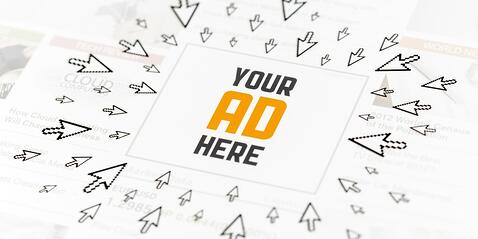3 Things Clickable Display Ads Have in Common

For companies seeking to build brand recognition, display ads offer an affordable way to reach your target audience. In 2016, companies spent an estimated $3 billion more on display ads than on search ads, according to a study by PowerTraffick. And another study by eMarketer suggests banner ad spend is expected to reach $37 billion in 2017. Adweek recently reported over 634 billion impressions for display ads for January 2017 alone. These are some pretty big numbers that we can’t ignore.
While banner ads can be highly effective for building brand awareness, getting people to click on your ad requires many essential elements. Here are three important components clickable display ads have in common to get you headed in the right direction.
1. Strong Design
Solid banner ad design is critical to capturing the attention of your audience. The key is to keep it simple. Your audience is likely to look at your ad only for a few seconds, so it’s critical to make it easy and quick for them to understand.
For example:
- Don’t clutter your ad with too many images, graphics, or text.
- Include images only if they directly relate to your product or service.
- Consider purchasing a stock photo license for high-quality images.
To make your text stand out, here are a few things you can do:
- Use different colors or fonts to draw attention to it. However, ensure that the colors are pleasing to the eye and project the feeling you want to convey to the audience you want to reach.
- If you use different fonts to highlight text, it’s a good idea to keep it to just two. Otherwise, your ad becomes too busy.
- Avoid cursive or lightweight fonts, as well as all caps or a font size smaller than 10 point.
Lastly, animation can be a good way to attract attention to your ad, but use it sparingly and ensure that it doesn’t distract from your message.
In general, you should find a balance between looking like you are meant to be on the web page on which your ad will appear—which helps to build trust—but not blending in so much that viewers won’t notice you.
For example, an ad for a health food delivery company on a website that’s very natural-looking in style with lots of earthy tones might use colors that match the website and that make people think of health food, but use design features and unique font to highlight their message and encourage a click on the CTA. These ads won’t be obnoxious and stand out because the colors don’t contrast that of the website, but they will stand out because they are easy on the eye, and the design directs the focus of the website visitor.
2. Powerful Message
A powerful message correlates to the success of your ads. The call-to-action as well as the specific words chosen both play a major role in that success.
Use these tips when designing the CTA on your creative:
- Make your CTA the clear focal point of your ad. Particularly for image-based ads, your CTA must be obvious.
- Use phrases such as “Learn more” or “Shop now.”
- Choose your messaging placement wisely. A general rule of thumb is to place your CTA as a button in the lower right-hand side of your ad, using contrasting colors.
- Choose colors based on messaging. For example, bold colors can convey a sense of urgency.
Choose your words carefully. Space is limited, so your wording should be brief but powerful. Certain words and phrases are more likely to result in a viewer clicking on your ad.
For instance:
- Implying exclusivity can be effective, using phrases such as, “Ask for an invitation,” or “Get it before everyone else.”
- Phrases like, “Supplies are running out,” or “Today only,” imply scarcity.
- You can help your audience feel more comfortable with words that suggest a lack of risk, such as “No obligation,” or “Try before you buy.”
3. Correct Size and File Format
The right file size and format are important to ensure your ads load quickly and they aren’t missed before the viewer has scrolled down the page.
- According to Google Adwords, the smaller the file size, the better—keep it under 150KB.
- File format should be JPG, GIF, HTML5, or PNG. (Avoid using Flash—this is pretty much out of date.)
Ad sizes are generally standardized—for example, a full-width banner ad is 468×60 pixels—but what’s standard is constantly evolving to continue to attract the attention of online viewers. Google AdSense lists the top performing banner ad sizes, but this will depend on the site you are advertising on:
- 728×90px — Leaderboard
- 300×600px — Half Page
- 300×250px — Medium Rectangle
- 336×280px — Large Rectangle
An experienced media partner will have an in-house creative team focused on ensuring your ads are developed to perform best with your target audience. They will deliver your ads at the right specs for the best user experience.
Display ads can be a great way to build brand recognition. Successful (i.e. clickable) display ads will drive your target audience to take a clear action. Include the three components explored above in your banner ads, and you’ll increase your chances of securing more clicks.
Share This
Subscribe
Stay on top of industry news and trends.
